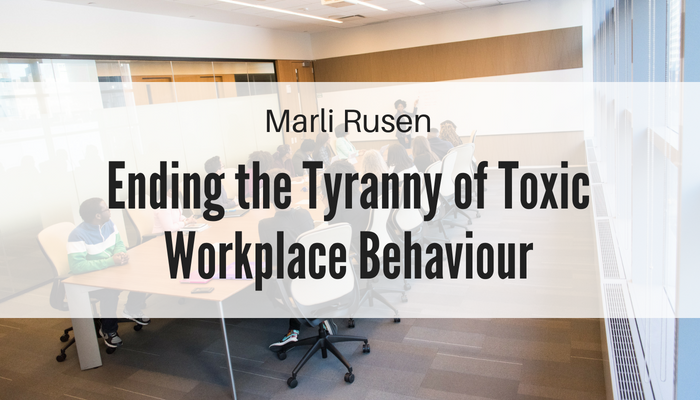Resources > Blog > Ending the Tyranny of Toxic Workplace Behaviour

Toxic workplace behaviours damage careers and ruin lives. They exact a heavy toll on countless individuals every year. Unfortunately, our untested assumptions and beliefs often cause unacceptable behaviour to go unchecked.
Do you believe that disrespectful, intimidating and offensive conduct is or should be permitted in certain workplaces? What if that workplace or industry has a longstanding culture of condoning or encouraging such behaviour?
The answer to both questions must be an emphatic “no” if we hope to change negative and unhealthy workplace cultures. There can be no equivocation or middle ground. There can be no exceptions to the rule of respect.
Thankfully, the tide is starting to turn: a healthy and enriching workplace is becoming a right, not simply a luxury.
My Front-Row Seat to Workplace Dysfunction
I train thousands of people every year on how to better manage workplace conflict and create high-functioning and high-performing teams. Participants have frequently shared that concerns regarding disrespectful, intimidating and offensive conduct, while interesting, “aren’t that relevant” to certain workplaces. Why? Because “that” type of behaviour is part of their “longstanding culture.”
“That’s just how we are” or “people who work here need to toughen up” are other justifications I hear for turning a blind eye towards organizational disrespect and dysfunction. And don’t let me forget one of my favourites: “we’re old school here.”
These statements are frequently made by those, leaders and staff alike, who reject the notion that workplace respect is an expectation, not a “bonus.”
The truth is this – systemic discrimination and harassment will end only when each one of us confronts untested and often unspoken beliefs of what is acceptable in their workplace. If we do not, victims will continue to think they must “take it” if they want to keep their jobs. And offenders will believe they’ve done nothing wrong since those around them engage in similar behaviour – or, at the very least, turn the other way when it happens.
The Legal View of Toxic Workplace Culture
The suggestion that a “certain type” of workplace is immune from the requirement to protect workers from bullying is a myth.
The Human Rights Code, Workers Compensation Act and other relevant legislation draw no distinction between industries. There are no differing expectations between those who work at a construction site, for example, and those who work in a candy store.
Discrimination is discrimination. Harassment is harassment.
This was rightly reinforced in a recent decision by Arbitrator Stan Lanyon in Teck Coal Limited v. United Steelworkers, Local 9346 (June 20, 2018). In this case, the arbitrator upheld the termination of a worker fired from a coal mine for bullying his co-worker.
In doing so, the arbitrator said:
The harassment and bullying of an employee may amount to a serious disciplinary issue. Certainly, repeated conduct that involves intimidation and bullying that causes distress, and endangers the safety of an employee and/or results in a poisonous work environment, is capable of discipline up and to including discharge; indeed, a single incident, such as the threat of violence, or an egregious incident of bullying, may be sufficient grounds for the termination of employment.
Arbitrator Lanyon made it clear that “no one is required to work in fear of his fellow employees, nor does any employee have to “put up” with or accept harassment and bullying as the price of their employment.”
The Union argued that the employee’s conduct was consistent with the “blue collar culture” at this mine site. The arbitrator wholly rejected this argument:
I do not accept this rationale when it involves the breach of harassment and bullying policies or conduct in violation of the Human Rights Code. I agree with Arbitrator Nichols decision in a sister property of this Employer: Teck Metals Limited (Trail Operations) and United Steelworkers, Local 480, April 7, 2015, in which she writes that in today’s workplace the “basic expectation” is that employees should not and will not violate the Human Rights Code, nor harass or bully other employees. …. This is consistent with all the Union’s essential goals, which include the dignity of each employee, and a safe workplace.
The arbitrator offered a strong word of caution to those who still maintain that workplace culture excuses individual behaviour, stating:
…and in circumstances where an employee or a union is perceived to protect the offender at the expense of the victim, it will, in the case of an employee, open themselves up to discipline, or in the case of a Union, potentially put itself in breach of its statutory duties under both the Labour Relations Code R.S.B.C. 1996 c.244 and the Human Rights Code.
The First Step to Ending Toxic Cultures is Individual Accountability
Workplace culture must no longer be used as a vehicle to tolerate the intolerable.
What should you and I do differently? The answer is simple.
We must hold individuals accountable for what they say, for what they do and for how their actions affect those around them. In doing so, we will ensure that, over time, “workplace culture” and “respectful workplaces” are one and the same.
I said the answer was simple, not easy.
Are you ready to stand-up for healthy, enriching places of work? Are you ready to lead teams of excellence? Do you need a hand in creating a workplace defined by respect and dignity, where everyone is given the opportunity to do their best work in a safe space?
If the answer to any of these questions is “yes,” please contact our organization today.
To learn more on how Marli can help your team build relationships of respect and effectively communicate through conflict, contact Marli at 1-877-590-8153 or Marlirusen.com.
Order your copy of “Walking On Eggshells?”
LEARN MORE ABOUT:
